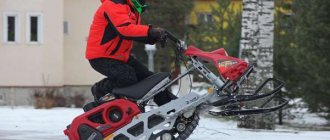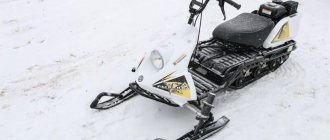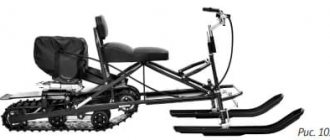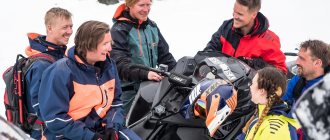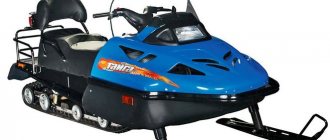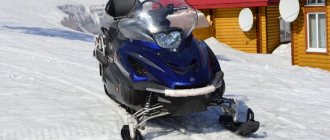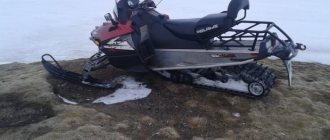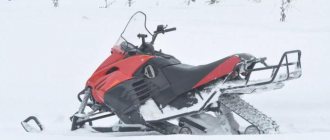Rybinka 4 is a universal snowmobile for professional fishermen and hunters, in demand throughout the post-Soviet space. This relatively modern model will satisfy the needs of the most demanding users, for whom, when purchasing, the most important things are carrying capacity, maintainability and reliability. The model in question is capable of reaching its destination through huge deep snowdrifts and covering long distances, being many kilometers away from civilization. Rybinka 4 is a relatively compact car that costs little money, and at the same time is a universal transport. Before us is a so-called mini-snowmobile, created at an enterprise in the city of Rybinsk. The machine is presented in the form of a small-sized “transformer” that can be placed in the trunk of a car without much effort, and its assembly and disassembly takes a matter of minutes. In addition, this procedure does not require the use of professional tools - it is enough to use the basic set included in the package. Based on this, we can conclude that Rybinka 4 is a worthy offer for lovers of winter fishing and hunting.
It must be admitted that compared to its competitors, Rybinka 4 has rather modest technical characteristics. Despite this, the machine is considered a full-fledged snowmobile with excellent ergonomics of the driver's workplace. When driving this snowmobile, the driver does not stand or lie down, but rather sits with sufficient comfort for this price category. The seating is comfortable and spacious, it will accommodate a person of any height and build. If necessary, the seat can be adjusted in height. There are no conventional instrumentation, since the main goal of the developers was to reduce the cost of the design as much as possible and make the machine accessible to the mass consumer and to novice users. Therefore, you should not be surprised if the driver notices that this car does not even have a fuel gauge. There is also no windshield, which is not provided as an option. However, the developers still installed a halogen headlight in front, which is located quite high and provides good illumination in any bad weather.
The snowmobile of the same name weighs more than 100 kilograms, is equipped with one track and two skis. The chassis is of the roller type. The dimensions of the track are quite impressive for this class - the length is 2070 mm, and the width and height of the lug are 280 and 25 mm, respectively. Thanks to these parameters, it was possible to provide good ride quality, comparable to more expensive snowmobiles from the next price category. In the front part there are two skis mounted on “telescopes”. The power plant is located in the rear, and is rigidly fixed to the “stern”.
The Rybinka 4 snowmobile has optimal useful properties in terms of load capacity. The machine is capable of transporting up to 150 kg of cargo. In addition, the maximum speed of the Rybinka 4 snowmobile is 20 km/h. In addition to electric start, the device is equipped with wind protection and a heated steering wheel. These basic options will come in handy in harsh climates. As practice has shown, the car performs excellently on loose snow, as well as on an icy road or simple ground. Such good driving characteristics were achieved thanks to the track roller suspension, which can withstand heavy loads without any serious damage. The car will have a more difficult time in deep snow, but its chassis can cope with such obstacles.
Description
This device is also called a motorized towing vehicle or a transformer.
A motorized towing vehicle - because it can tow a trailer weighing up to 150 kg, with its own weight of 110 kg.
Transformer - because it can be disassembled into eight separate parts:
- motor with motor frame;
- steering column;
- electric starter;
- two skis with steering linkage;
- footrest;
- track suspension;
- side frame;
- circuit protection.
Each part weighs no more than 40 kg. It is easy to disassemble and transport in the trunk of a car to the place where the off-road begins. Collect within 5-8 minutes and then move off-road to the fishing spot.
Another advantage would be the use of a four-stroke gasoline engine. American single-cylinder Kohler units with a capacity of 7 horsepower. They work perfectly at sub-zero temperatures down to -35°C. Air cooled, started with an electric starter. Can be started using a manual starter.
The transmission is a variator with a chain drive and an automatic centrifugal clutch. Fuel supply is carburetor. Contactless ignition. To facilitate maintenance outside the garage, plastic covers can be easily removed to provide access to all units and components. The metal frame is coated using modern powder technology. This is effective protection against corrosion.
Reliable suspension – telescopic for two skis in front. Balancer-roller for the engine and skis at the rear.
The track is 38 centimeters wide and has an increased support area allowing it to move through snowy, moderate off-road conditions. On bare ice or compacted snow, a snowmobile can travel for a long time at speeds of up to 45 kilometers per hour.
An ergonomic seat has been designed for ease of movement. The driver can operate the device while sitting, standing, half-sitting or leaning on the seat with his knee. There is a large storage compartment under the seat. Even more things can be transported on a trailer. The mechanism is designed to transport a ski trailer or sled weighing up to 150 kg.
Another fact that speaks in favor of “Rybinka” is that the small-scale mechanization device does not require registration and obtaining permission from the management of a snowmobile or “motorized dog”.
Specifications
- Engine – petrol, displacement 0.2 liters
- Other parameters of the internal combustion engine: two-stroke, power – 7 liters. With.
- Lubrication system – separate type
- Recommended engine oil: 0W40, API-SJ, 4T Showmobile RM
- Chassis – two skis and one caterpillar
- Total weight – 110 kg
- Suspension front and rear – independent
- Recommended fuel – AI-92
- Brakes – disc, mechanical
- Gas tank volume – 28 liters
- Cooling – air
- Dimensions of the snowmobile, mm: Length – 208 cm, Length without skis – 195 cm, height to the windshield – 103 cm; width with skis – 91 cm.
- Gearbox – variator with reverse
Basic options - heated handles, two luggage compartments - in the back and under the seat.
Self-assembly
When disassembled, the structure takes up little space. Assembly before use is simple and intuitive. Anyone can do it, but you need to read the operating instructions carefully. In addition to assembly instructions and technical specifications, it contains advice on conducting technical inspections and observing safety precautions.
The assembly sequence is as follows:
- remove parts from the transport container;
- install the bracket between the ski and the king pin and secure it with an M8 x85 bolt;
- fix the steering rods in the ball joints;
- install the caterpillar mover and traverse on the frame;
- install the guard and footrests on the frame with a caterpillar drive;
- secure the seat in the frame with two clamps and a stopper;
- secure the steering wheel in the steering column with a stopper;
- add fuel and oil according to the instructions;
- adjust track tension;
- check the operation of the mechanisms.
Maintenance
Like any other unit equipped with a gasoline engine and electrical equipment, a motorized snowmobile requires timely maintenance.
The instructions for the unit state that there are several types of maintenance:
- Daily maintenance of the EO;
- Maintenance after running in;
- TO-1;
- TO-2;
- CO.
Daily Maintenance
EO – daily maintenance. Carried out daily before use.
Includes:
- Check the operation of the gas lever (throttle valve drive) for smooth operation. When released, the lever should return to its original position on its own.
- Checking the brake mechanism. The brake should fully engage and return to place when the brake lever is released.
- Checking the condition of the caterpillar. An external inspection is done and the tension is checked.
- Checking the serviceability of the steering.
- The fuel and oil levels are determined.
- An external inspection of the casings is carried out, the tightening of the bolts, the availability of tools and spare parts are checked.
- Inspection of the towing device.
- Check the operation of the emergency stop, the serviceability of electrical equipment.
After use, the unit is thoroughly cleaned of dirt and ice, all places where water has accumulated are wiped off, and inspected for any malfunctions. All detected defects are eliminated.
Maintenance after break-in
After the break-in (check after the engine has operated for 5 engine hours), maintenance is performed similar to TO-1.
Maintenance TO-1
Maintenance service TO-1 is carried out after the engine has been running for 20 hours.
It includes:
- Checking the starting system (manual start), condition of the starting cord.
- Inspection of the exhaust gas system;
- Checking the condition of the engine cooling system.
- Checking the fuel system. If necessary, eliminate leaks.
- Change of oil.
- Checking the variator mounting.
- Adjusting the brake mechanism.
- Checking the functionality of the transmission chain tensioner.
- Inspection of skis, checking wear of skis and runners.
- Checking electrical equipment:
- checking and adjusting the spark plug gap;
- wiring condition monitoring;
- adjusting and checking the serviceability of the headlight.
11. General inspection of the snowmobile.
Maintenance TO-2
TO-2 is carried out after 50 hours of driving. Includes all operations performed during TO-1 and additional operations:
Checking the front suspension and steering.
Check and adjust, if necessary, the geometric parameters of the steering.
Seasonal service
Held at the end of the season. TO-1, TO-2 are performed. In addition, the apparatus is preserved for preservation in the summer.
To do this, lubricate the rubbing parts according to the diagram in the table of the operating instructions. All parts are first cleaned of old grease and dirt. Then processing is carried out. To do this, use the lubricants specified in the instructions.
Purpose and characteristics
The construction of snowmobiles began in Soviet times, when in 1971 the first vehicles for moving on snow appeared: “Buran” and “Taiga”. After that, more than two hundred thousand of these products were produced. Today's models differ from their predecessors in their interesting design and better technical characteristics. Having proven themselves to be the best, snowmobiles from the “Rybinka” series are very popular among winter fishing enthusiasts.
A snowmobile is a sled with an engine installed . Its movement is controlled using a steering wheel connected to the skis. On the steering wheel, like in any other motorcycle, there are gas and brake levers. The rear wheels are made in the form of a rubber caterpillar belt connected to the engine by a gear mechanism. The Rybinka motorized towing vehicle can be used not only for fishing, but also for traveling through snow-covered expanses, which are impossible to travel in a regular vehicle.
Vehicle parameters
The Rybinka mini-snowmobile is a transformer that can be easily placed when disassembled even in a small-sized vehicle. Disassembly and assembly itself takes no more than ten minutes and does not require special knowledge or tools.
The engine used is a four-stroke single-cylinder Subaru Corporation or KOHLER engine with a power of seven horsepower.
The motorized towing vehicle is designed to carry one person, and it is equipped with a coupling device that allows you to transport a trailer with a total weight not exceeding 150 kg. To start the snowmobile, both an electric starter and a manual drive are used.
The main technical characteristics of the product include:
- number of passengers: one;
- snowmobile dimensions: 2.2x0.91x0.96 m;
- track dimensions: 2.4×0.38×0.17 m;
- track size: 0.8 m;
- highest speed: 55 km/h;
- engine type: four-stroke, manufactured by KOHLER (USA) or Subaru Corporation (Japan);
- engine capacity: 208 cc cm;
- fuel used: A-92 gasoline;
- tank volume: 4 l;
- transmission with CVT (not available in latest models);
- gearbox: two-stage with reverse;
- suspension type: telescopic and on rubberized supports;
- manufacturing material: sheet steel (frame), plastic (hood, skis);
- light: low (50 W) and high (60 W);
- weight: 110 kg.
The weight of the heaviest part of the structure is forty kilograms, so one person can disassemble and assemble it. Additionally, the kit may include a windshield, a battery, a heated steering system, and a bag for storing keys. It is recommended to use a battery with a capacity of 10 A/h as a battery . Design features include: roller spring engine suspension and transmission with a variator.
There is a luggage compartment under the seat. It can easily accommodate all the accessories needed for fishing.
Mini snowmobile design
According to the classification, the product of the Rybinsk enterprise is a means of small-scale mechanization that does not require registration. Studying reviews of the Rybinka snowmobile on specialized forums, it can be noted that the majority of consumers like the appearance of the vehicle, which has smooth lines, as well as its technical characteristics. Structurally, the device is designed so that it can easily be disassembled into eight parts:
- motor with motor frame;
- starting electric motor;
- steering column;
- skis with steering linkage;
- footrests;
- track suspension;
- side frame;
- circuit protection.
History of development
Since 2013, when the first Rybinka was released, the snowmobile has had a four-stroke Japanese Subaru EX21 engine and a Canadian CVTech variator. The device developed power from 5 to 7 horsepower. The suspension was roller with spring. The mechanism had problems starting at low temperatures. Therefore, they began installing the American KohlerCH270 engine in Rybinka-2. The engine also developed a power of 7 hp. With. The variator was replaced with a box with a centrifugal dry clutch made in China. The spring was removed from the suspension.
Such savings significantly reduced the cost of the device. The engine “hit the mark,” but after replacing the variator with a clutch, big problems appeared on all snowmobiles due to the clutch. It could not withstand the loads and broke down on the first or second trip.
The Canadian CVT was returned to the released third and fourth generations of Rybinka. Added some design changes:
- installed running boards that improved the snowmobile's handling;
- modified fastening elements;
- Design errors have been corrected.
The result of “Rybinka-4” shows a good price/quality ratio for the snowmobile.

